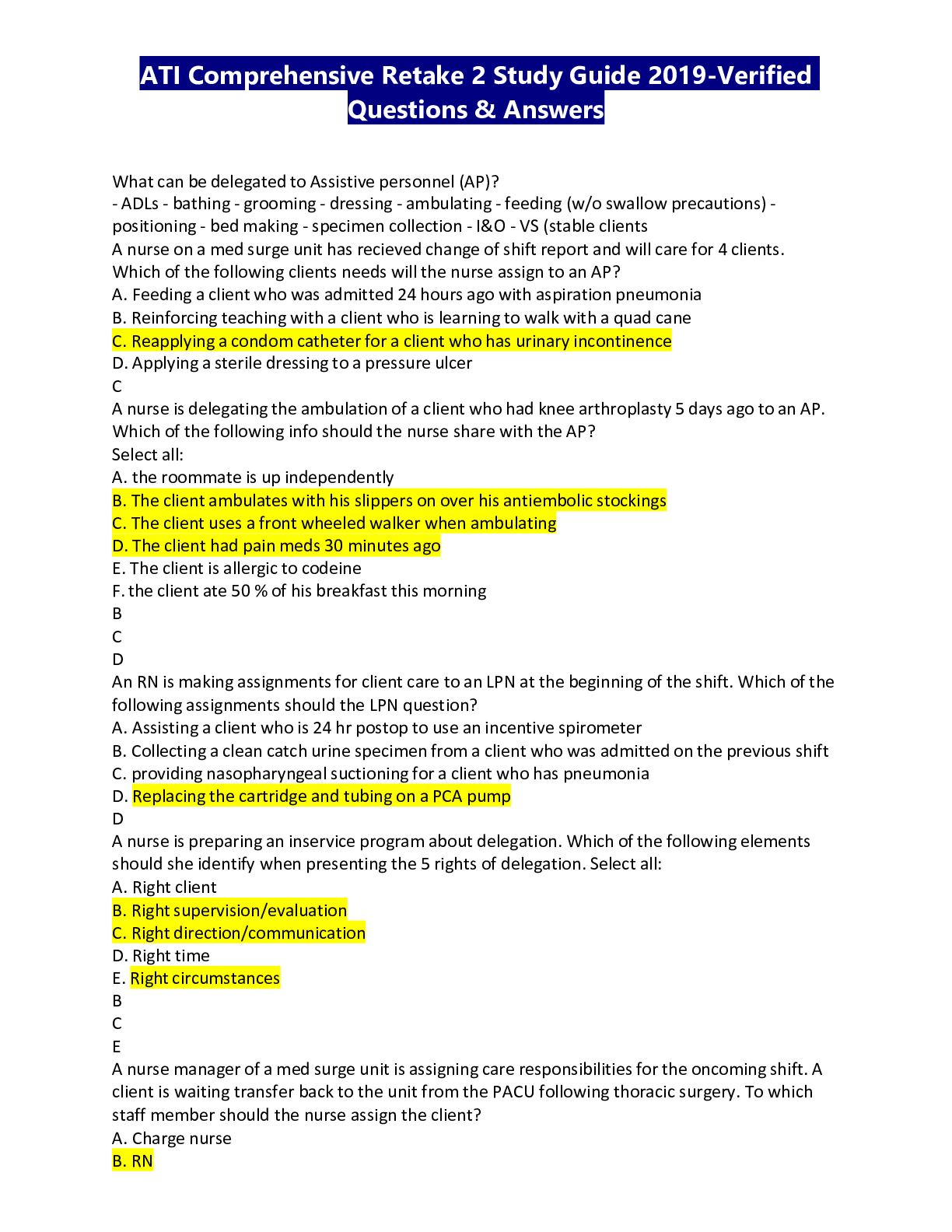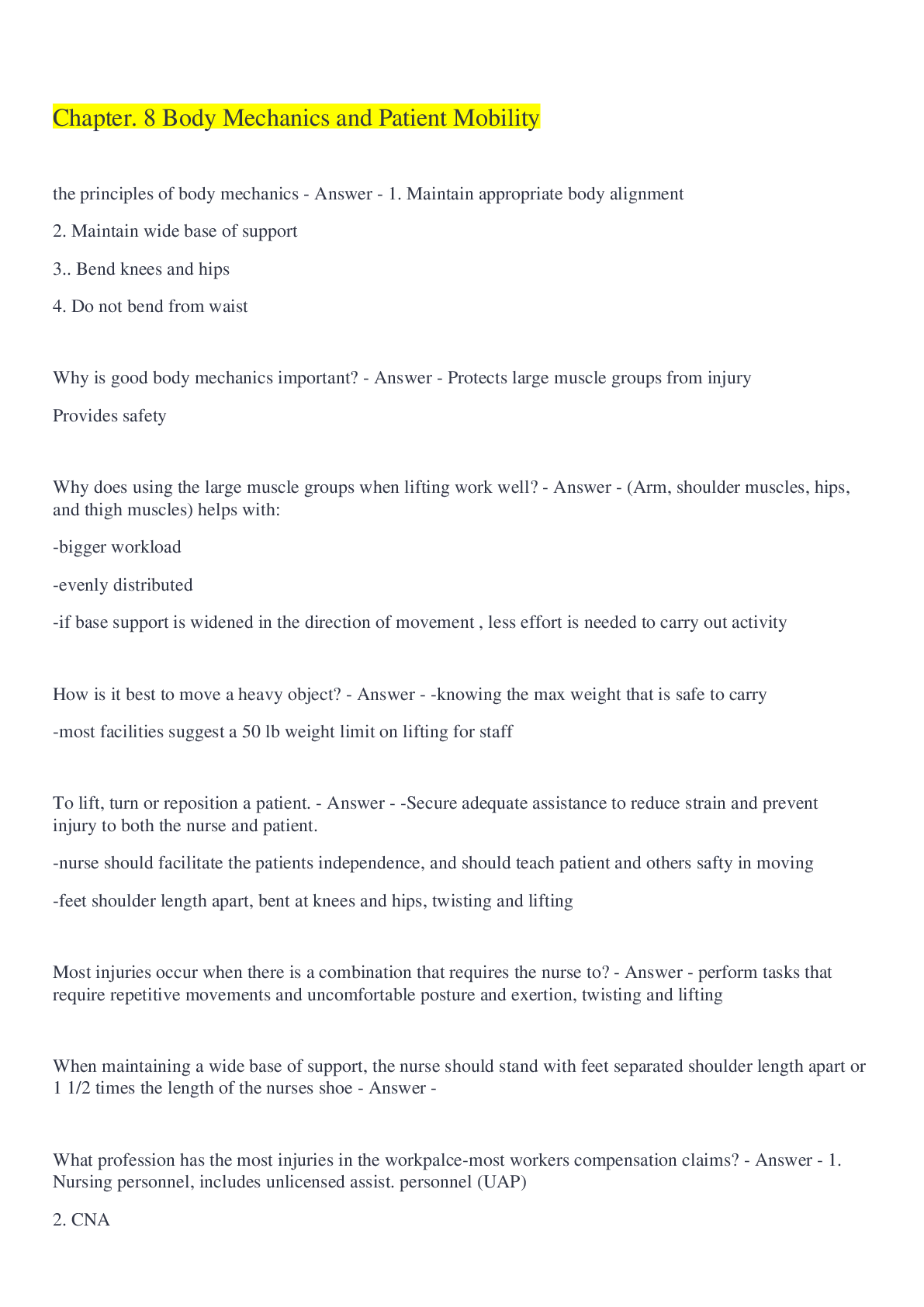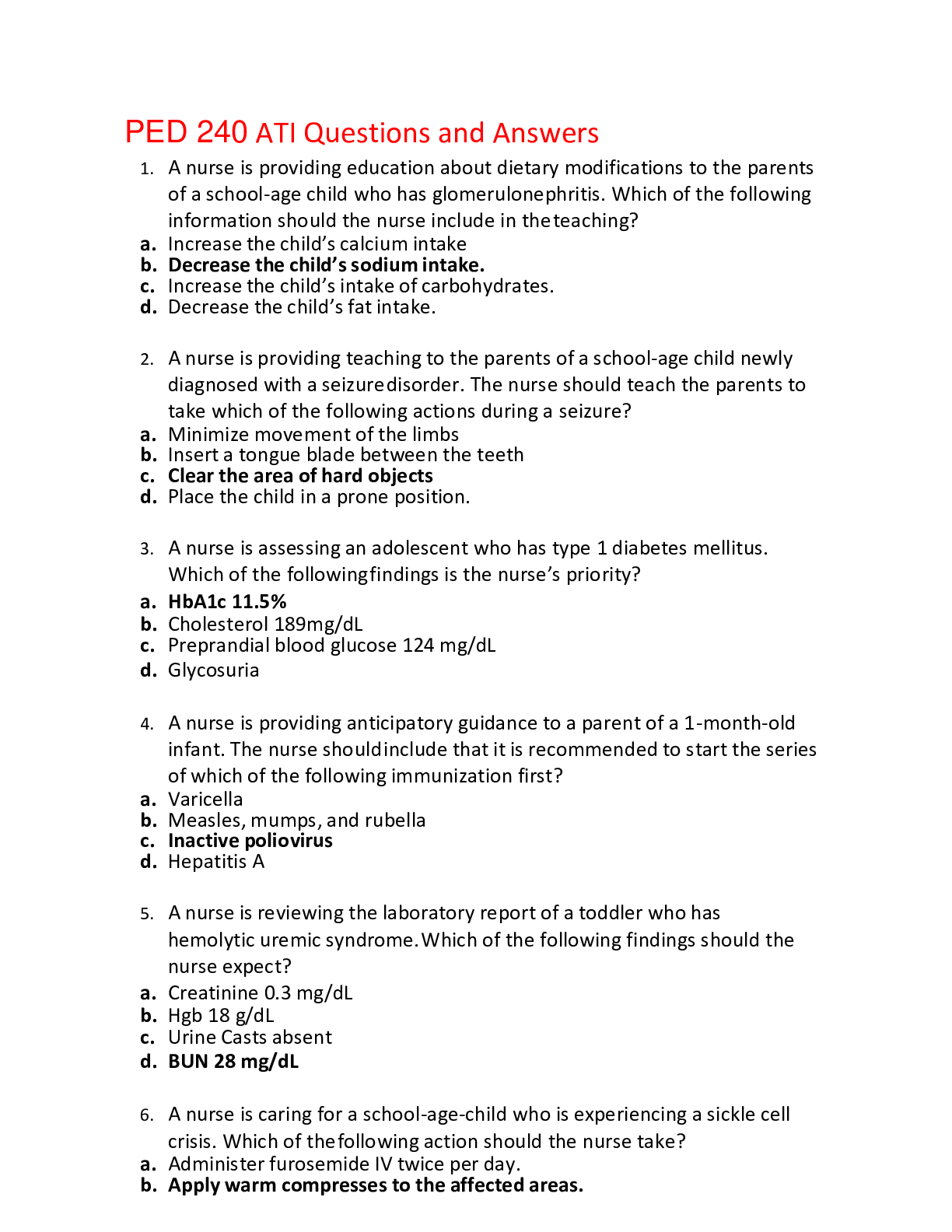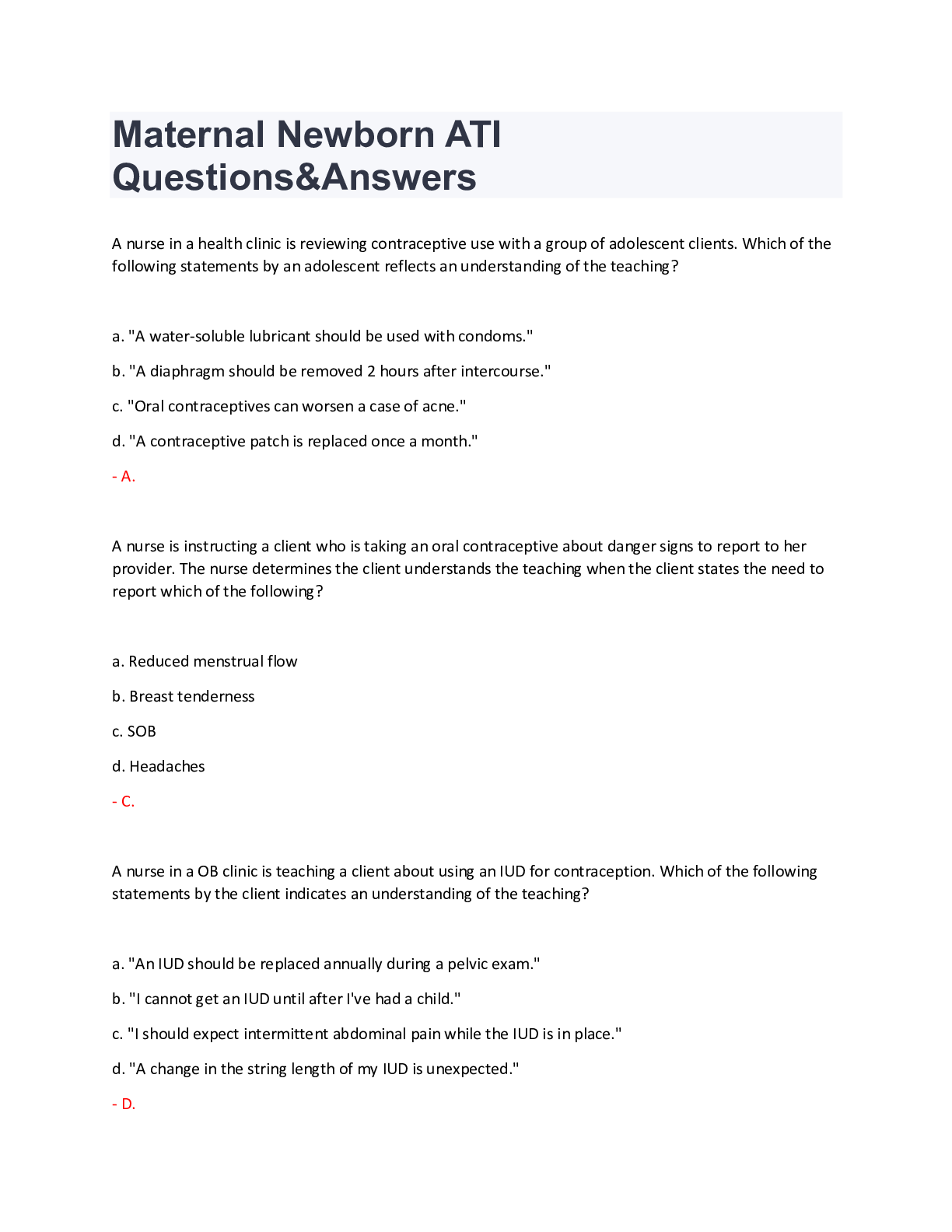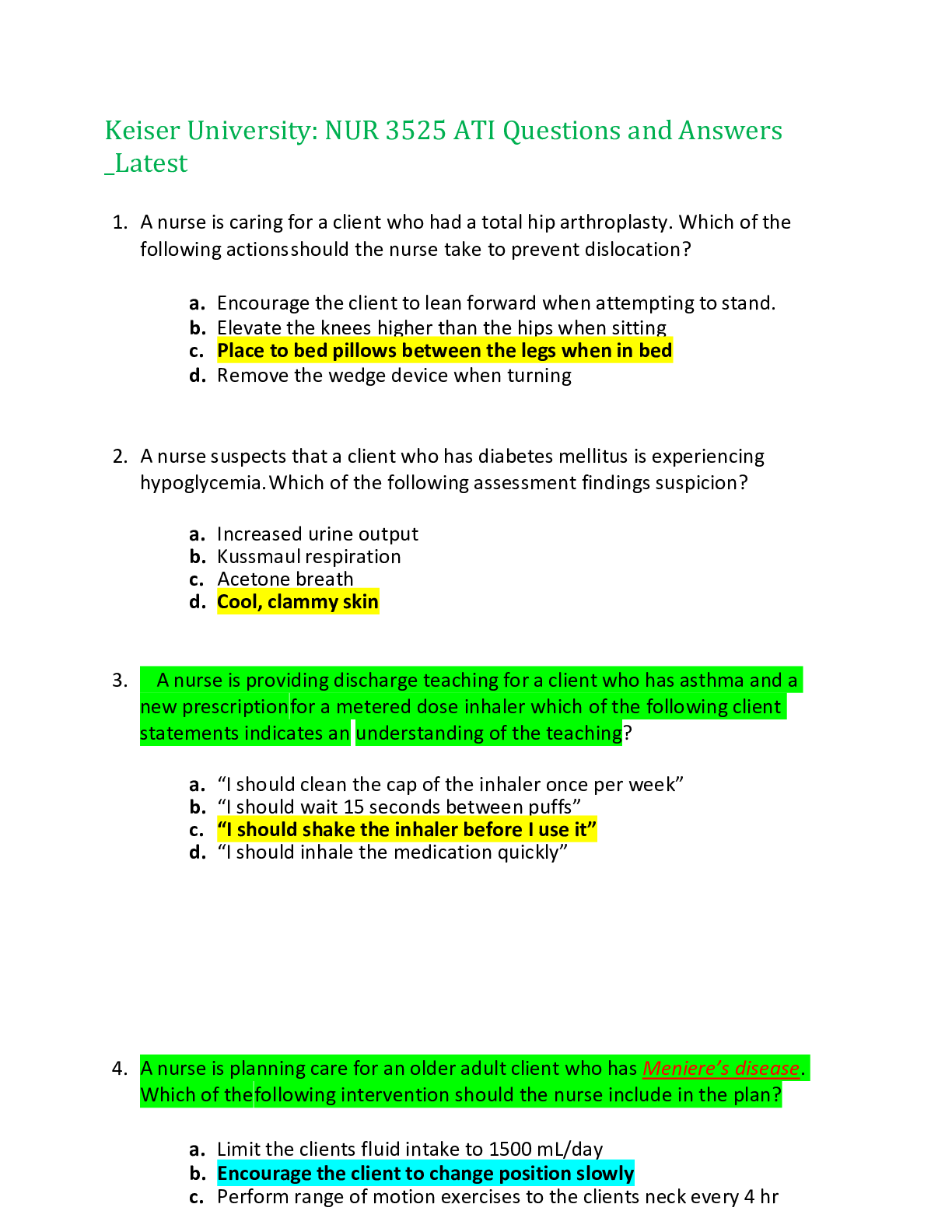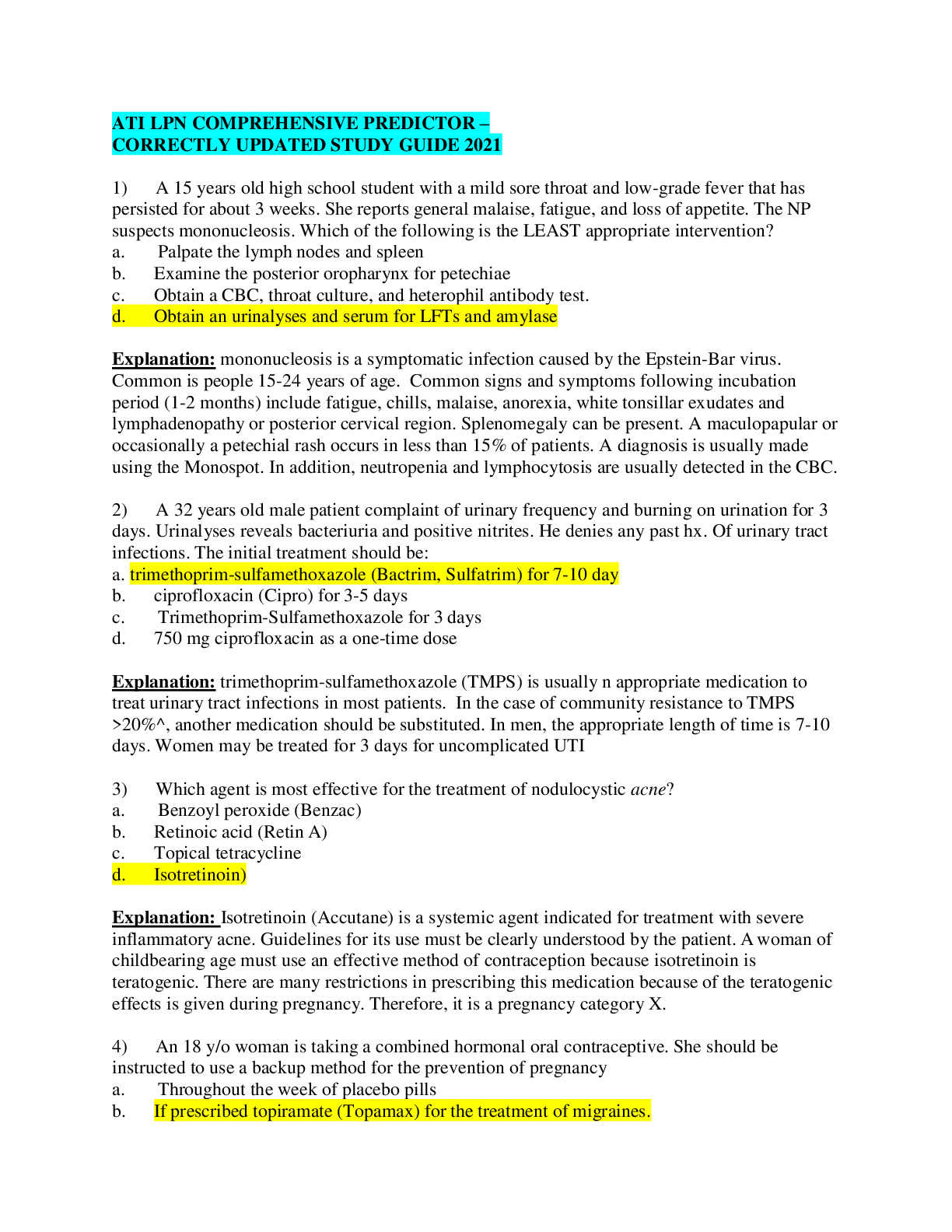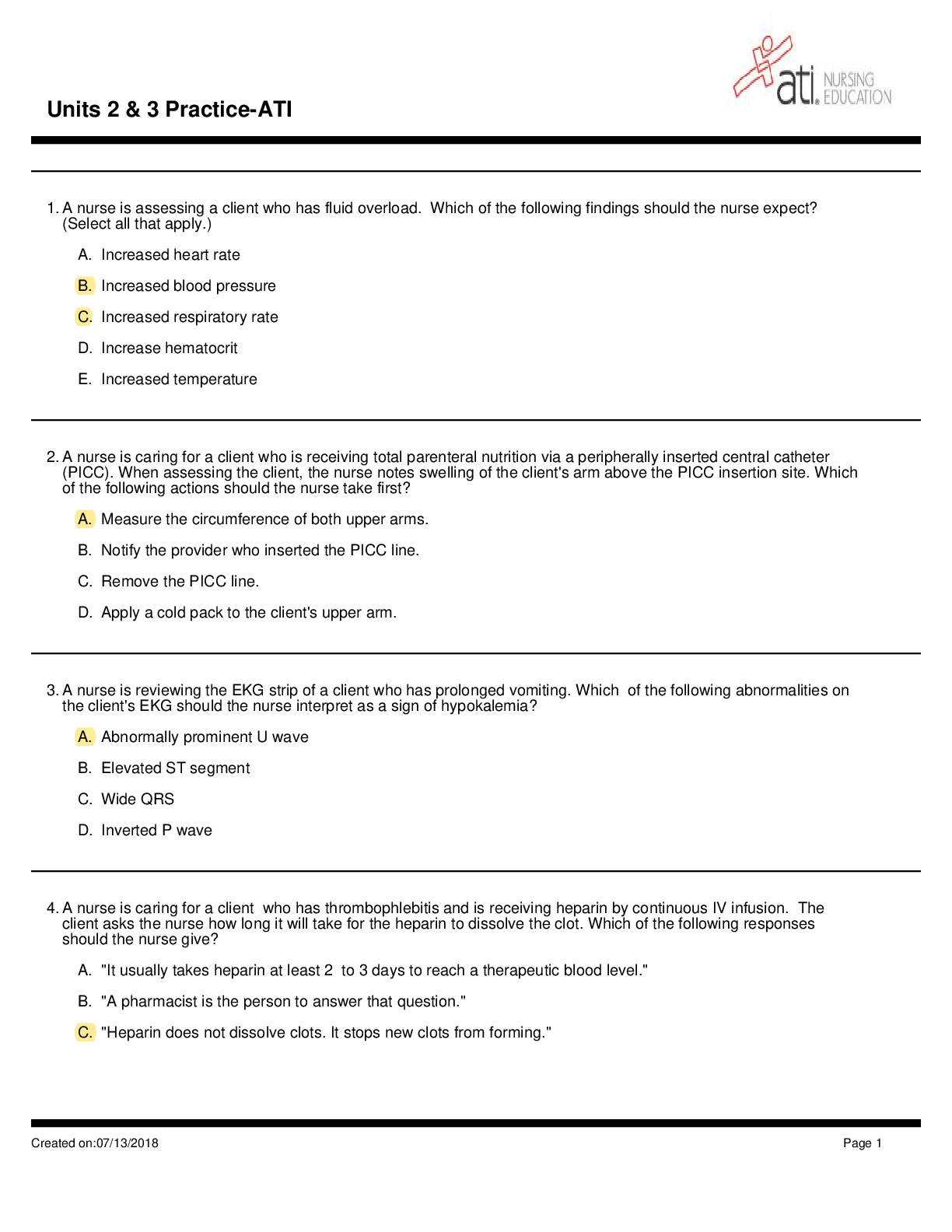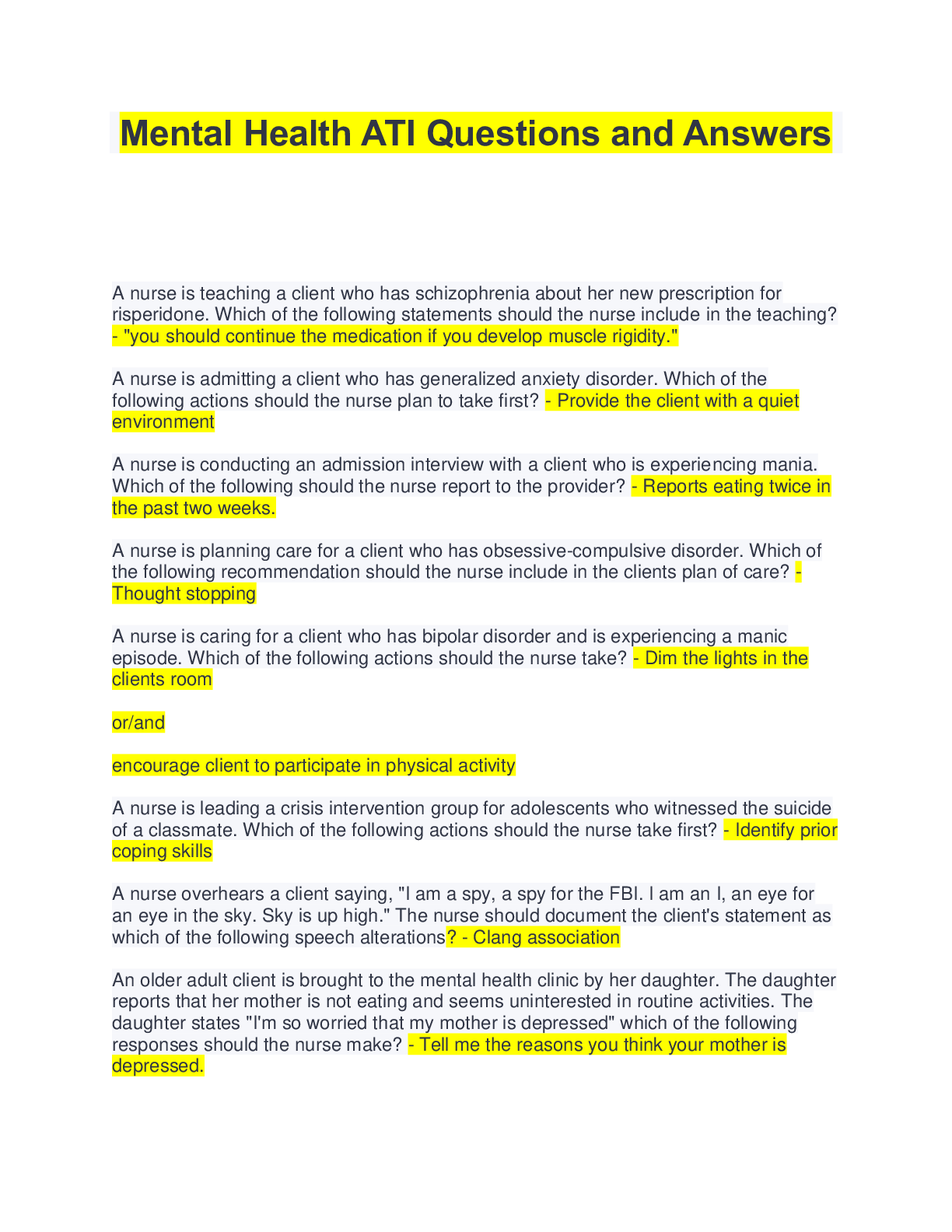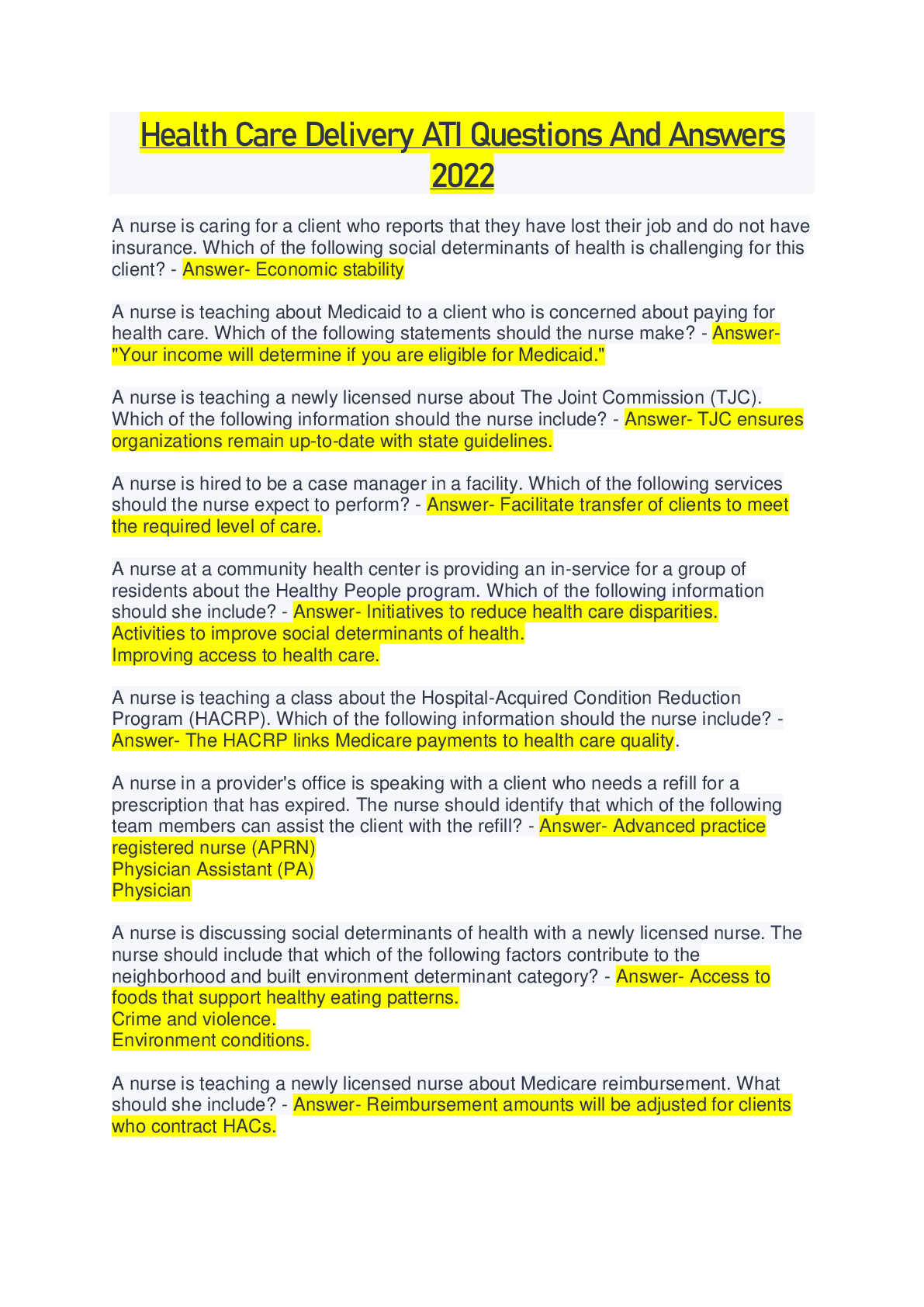OB Ati Questions and Answers Key Medical STUDY GUIDE 2021 COMPLETE SOLUTIONS
Document Content and Description Below
1.A nurse is caring for a client who is at 36 weeks of gestation and who has a suspected placenta previa. Which of the following findings support this diagnosis? A. Painless red vaginal bleeding Ra... tionale:Placenta previa is a condition of pregnancy when the placenta implants in the lower part of the uterus, partly or completely obstructing the cervical os (outlet to the vagina). Bright red, painless vaginal bleeding occurs in the second and third trimester. B. Increasing abdominal pain with a nonrelaxed uterus Rationale:Abruptio placenta is separation of the placenta from the site of uterine implantation before delivery of the fetus. When the placenta separates prematurely, there is internal bleeding, which is painful, and the uterus is nonrelaxed or becomes rigid as the separation advances. C. Abdominal pain with scant red vaginal bleeding Rationale:Placenta previa involves minimal to severe bright red vaginal bleeding in the absence of abdominal pain. D. Intermittent abdominal pain following passage of bloody mucus Rationale:Intermittent abdominal pain following passage of bloody mucus is a description of normal labor. The passage of bloody mucus represents the loss of the cervical mucous plug, also referred to as the "bloody show." 2.A nurse is caring for a client who is 1 hr postpartum and observes a large amount of lochia rubra and several small clots on the client's perineal pad. The fundus is midline and firm at the umbilicus. Which of the following actions should the nurse take? A. Document the findings and continue to monitor the client. Rationale: These are expected findings. At 1 hr postpartum, lochia rubra should be intermittent and associated with uterine contractions. The volume of lochia resembles that of a heavy menstrual period. Small clots are common. The nurse should document the findings and continue to monitor the client. B. Notify the client’s provider. Rationale: These are expected findings, so there is no need to notify the provider. C. Increase the frequency of fundal massage. Rationale: These are expected findings and the fundus is already firm. Increasing the frequency of fundal massage is not indicated at this time. D. Encourage the client to empty her bladder. Rationale: These are expected findings, and the fundus is firm at the midline. If the fundus was deviated, this would be an indication of a distended bladder and the client should be encouraged to void to prevent uterine atony. Created on:11/29/2018 Page 1 Detailed Answer Key medical 3.A nurse is caring for a newborn immediately following birth. After assuring a patent airway, what is the priority nursing action? A. Administer vitamin K. Rationale:Administration of vitamin K is important, but it can be delayed until the newborn is held by the mother and is breastfed. There is another, more important nursing action. B. Dry the skin. Rationale: The newborn should be thoroughly dried, covered with a warm blanket, placed on the mother’s abdomen, and a cap applied to the newborn’s head to prevent cold stress. The newborn responds to the cooler environment by increasing his respiratory rate, which can lead to respiratory distress. Based on Maslow’s hierarchy of needs, this is the most important nursing action after securing the airway. C. Administer eye prophylaxis. Rationale:Administration of eye prophylaxis should occur within the first hour after birth. There is another, more important nursing action. D. Place an identification bracelet. Rationale: Correct identification of the newborn is important, but it can be delayed, as long as it is completed prior to the mother and newborn leaving the delivery room. There is another, more important nursing action. 4.A nurse in a prenatal clinic is caring for a client who is at 7 weeks of gestation. The client reports urinary frequency and asks if this will continue until delivery. Which of the following responses should the nurse make? A. "It's a minor inconvenience, which you should ignore." Rationale: This is a nontherapeutic response that disregards the client’s concern and offers unwarranted reassurance. B. "In most cases it only lasts until the 12th week, but it will continue if you have poor bladder tone." Rationale: The presence or absence of bladder tone has no bearing on urinary frequency during pregnancy. C. "There is no way to predict how long it will last in each individual client." Rationale: This is a nontherapeutic response that does not provide appropriate information to the client. D. "It occurs during the first trimester and near the end of the pregnancy." Rationale: Urinary frequency is due to increased bladder sensitivity during the first trimester and recurs near the end of the pregnancy as the enlarging uterus places pressure on the bladder. Created on:11/29/2018 Page 2 Detailed Answer Key medical 5.A nurse is caring for a client during the first trimester of pregnancy. After reviewing the client's blood work, the nurse notices she does not have immunity to rubella. Which of the following times should the nurse understand is recommended for rubella immunization? A. Shortly after giving birth Rationale: The rubella immunization should be offered to the client following birth, preferably prior to discharge from the hospital. This prevents the client from contracting rubella during the current or subsequent pregnancies, which would put her fetus at risk for rubella syndrome. B. In the third trimester Rationale:Because the rubella vaccine contains a live virus, immunizing the client at this point in pregnancy would put her fetus at risk for developing rubella syndrome. C. Immediately Rationale:Because the rubella vaccine contains a live virus, immunizing the client during the first trimester would put the fetus at risk for developing a severe manifestations of rubella syndrome. D. During her next attempt to get pregnant Rationale: Rubella immunization must be given at least 28 days prior to pregnancy to assure that the developing fetus is not exposed to the virus and put at risk for rubella syndrome. 6.A nurse is caring for a client who just delivered a newborn. Following the delivery, which nursing action should be done first to care for the newborn? A. Clear the respiratory tract. Rationale: Clearing the airway of the infant is the first action the nurse should take immediately following delivery. B. Dry the infant off and cover the head. Rationale: Drying the infant and covering the head should be done shortly after the delivery, but it is not the first action the nurse should take. C. Stimulate the infant to cry. Rationale:Stimulating the infant to cry should be done shortly after the delivery, but it is not the first action the nurse should take. D. Cut the umbilical cord. Rationale: Cutting the umbilical cord should be done shortly after the delivery, but it is not the first action the nurse should take. 7.A nurse in a family planning clinic is caring for a 17-year-old female client who is requesting oral contraceptives. The client states that she is nervous because she has never had a pelvic examination. Which of the following responses should the nurse make? Created on:11/29/2018 Page 3 Detailed Answer Key medical A. "What part of the exam makes you most nervous?" Rationale: This therapeutic response recognizes the client's feelings. It also uses the therapeutic technique of clarification to encourage the client to tell the nurse more about her concerns. B. "Don't worry, I will be with you during the exam." Rationale: This closed-ended nontherapeutic response discounts the client's feelings and does not encourage further discussion. C. "All you need to do is relax." Rationale: This closed-ended nontherapeutic response does not address the client's concerns and does not encourage further discussion. It blocks communication by using a cliché and false reassurance. D. "A pelvic exam is required if you want birth control pills." Rationale: This statement fails to address the client’s feelings that she shared with the nurse. It blocks communication and does not encourage further discussion. 8.A nurse in labor and delivery is caring for a client. Following delivery of the placenta, the nurse examines the umbilical cord. Which of the following vessels should the nurse expect to observe in the umbilical cord? A. Two veins and one artery Rationale: This is not the correct combination of vessels. B. One artery and one vein Rationale: This is not the correct combination of vessels. C. Two arteries and one vein Rationale: The vein carried the oxygenated, nutrient-rich blood from the placenta to the fetus, and the two arteries returned the blood to the placenta. D. Two arteries and two veins Rationale: This is not the correct combination of vessels. 9.A nurse is caring for a client who is considering several methods of contraception. Which of the following methods of contraception should the nurse identify as being most reliable? A. A male condom Rationale: This method of contraception has 11 to 16 failures for every 100 users. B. An intrauterine device (IUD) Rationale:An IUD is found to have a failure rate of less than 1 in 100 users, which makes it one of the most Created on:11/29/2018 Page 4 Detailed Answer Key medical reliable methods of contraception. C. An oral contraceptive Rationale: This method of contraception has about 8 failures for every 100 users, due to failure to take pill consistently and decreased efficacy when taken with certain medications. D. A diaphragm with spermicide. Rationale: This method of contraception has about 16 failures for every 100 users during the first year of use. 10.A nurse is caring for an antepartum client whose laboratory findings indicate a negative rubella titer. Which of the following is the correct interpretation of this data? A. The client is not experiencing a rubella infection at this time. Rationale:A negative rubella titer indicates the client is susceptible to the rubella virus. It does not indicate the presence or absence of a rubella infection. B. The client is immune to the rubella virus. Rationale:A negative rubella titer indicates the client is susceptible to the rubella virus. C. The client requires a rubella vaccination at this time. Rationale: Rubella vaccination during pregnancy is contraindicated because of possible injury to the developing fetus. D. The client requires a rubella immunization following delivery. Rationale:A negative rubella titer indicates that the client is susceptible to the rubella virus and needs vaccination following delivery. Immunization during pregnancy is contraindicated because of possible injury to the developing fetus. Following rubella immunization, the client should be cautioned not to conceive for 1 month. 11.A nurse in a hospital is caring for a client who is at 38 weeks of gestation and has a large amount of painless, bright red vaginal bleeding. The client is placed on a fetal monitor indicating a regular fetal heart rate of 138/min and no uterine contractions. The client's vital signs are: blood pressure 98/52 mm Hg, heart rate 118/min, respiratory rate 24/min, and temperature 36.4° C (97.6° F). Which of the following is the priority nursing action? A. Insert an indwelling urinary catheter. Rationale:An indwelling urinary catheter can be inserted in the delivery room just prior to delivery. This is not the priority nursing action. B. Initiate IV access. Rationale:Insertion of a large-bore IV catheter is the priority nursing action. The client is losing blood rapidly, has hypotension, and tachycardia. IV access will allow IV fluids and blood to be administered quickly if hypovolemia develops. Created on:11/29/2018 Page 5 Detailed Answer Key medical C. Witness the signature for informed consent for surgery. Rationale: Rationale C. This is not the nurse's priority action at this time. A family member can sign the consent form if needed. D. Prepare the abdominal and perineal areas. Rationale:Skin preparation can be delayed until just prior to a cesarean delivery. This is no the priority nursing action. 12.A nurse in a prenatal clinic is caring for a client who is suspected of having a hydatidiform mole. Which of the following findings should the nurse expect to observe in this client? A. Rapid decline in human chorionic gonadotropin (hCG) levels Rationale:A client who has a hydatidiform mole usually has an elevated serum hCG level. B. Profuse, clear vaginal discharge Rationale:A client who has a hydatidiform mole often has vaginal bleeding later in the pregnancy. This discharge can be dark brown, bright red, scant, or profuse. C. Irregular fetal heart rate Rationale: When a client has a hydatidiform mole, fetal heart tones are not heard since there is no developing fetus. D. Excessive uterine enlargement Rationale:A hydatidiform mole is a rare tumor that forms inside the uterus at the beginning of a pregnancy and results in the over-production of tissue that would normally develop into the placenta. This tissue consists of fluid-filled vesicles. A rapidly enlarging uterus is a classic finding in clients who have a molar pregnancy. It is often accompanied by severe nausea and vomiting, elevated human chorionic gonadotropin levels, signs of hyperthyroidism, and early onset of preeclampsia. 13.A nurse is caring for a new mother who is concerned that her newborn's eyes cross. Which of the following statements is a therapeutic response by the nurse? A. "I will call your primary care provider to report your concerns." Rationale: This is an inappropriate response by the nurse because it does not address the client's feelings of concern. B. "I will take your baby to the nursery for further examination." Rationale:It is not necessary for the nurse to complete additional examination of the newborn. This also does not address the client’s concerns. C. "This occurs because newborns lack muscle control to regulate eye movement." Rationale: Created on:11/29/2018 Page 6 Detailed Answer Key medical This addresses the client’s concerns because it provides information that addresses her concerns. The eyes of newborns are structurally incomplete and muscle control is not fully developed for 3 months. D. "This is a concern, but strabismus is easily treated with patching." Rationale: This is an inappropriate statement by the nurse because it offers unwarranted reassurance. The nurse is making an assumption that that should be addressed by the provider. 14.A nurse is caring for a client who is having a nonstress test performed. The fetal heart rate (FHR) is 130 to 150/min, but there has been no fetal movement for 15 min. Which of the following actions should the nurse perform? A. Immediately report the situation to the client's provider and prepare the client for induction of labor. Rationale: The fetus might not be moving because it is asleep, or there might be another benign reason. B. Encourage the client to walk around without the monitoring unit for 10 min, then resume monitoring. Rationale: Having the client walk is not likely to promote fetal movement. C. Offer the client a snack of orange juice and crackers. Rationale:A nonstress test depends upon fetal movement, and this fetus is most likely asleep. Most fetuses are more active after meals due to the increase in the mother's blood sugar. Giving the mother a snack will promote fetal movement. D. Turn the client onto her left side. Rationale: Turning the client onto her left side increases the placental perfusion of oxygen to the fetus, but the FHR of 130 to 150/min is not indicative of fetal distress. 15.A nurse on a labor unit is admitting a client who reports painful contractions. The nurse determines that the contractions have a duration of 1 min and a frequency of 3 min. The nurse obtains the following vital signs: fetal heart rate 130/min, maternal heart rate 128/min and maternal blood pressure 92/54 mm Hg. Which of the following is the priority action for the nurse to take? A. Notify the provider of the findings. Rationale: Calling the provider may be appropriate; however, this is not the priority intervention. B. Position the client with one hip elevated. Rationale:Based on Maslow’s hierarchy of needs, the client's need for an adequate blood pressure to perfuse herself and her fetus is a physiological need that requires immediate intervention. Supine hypotension is a frequent cause of low blood pressure in clients who are pregnant. By turning the client on her side and retaking her blood pressure, the nurse is attempting to correct the low blood pressure and reassess. C. Ask the client if she needs pain medication. Rationale: Created on:11/29/2018 Page 7 Detailed Answer Key medical The client's comfort should be addressed; however, this is not the priority intervention. D. Have the client void. Rationale: The client should be encouraged to empty her bladder every 2 hr during labor; however, this is not the priority intervention. 16.A nurse is caring for a client who is a primigravida, at term, and having contractions but is stating that she is "not really sure if she is in labor or not." Which of the following should the nurse recognize as a sign of true labor? A. Rupture of the membranes Rationale: The membranes can rupture spontaneously long before the onset of labor. B. Changes in the cervix Rationale:Assessment of progressive changes in the effacement and dilation of the cervix is the most accurate indication of true labor. C. Station of the presenting part Rationale:A client who is a primigravida will typically engage before labor and can enter labor at -1, 0, or even +1 station. D. Pattern of contractions Rationale:A client can have regular contractions for a significant period of time prior to the onset of true labor. 17.A nurse is preparing to administer magnesium sulfate IV to a client who is experiencing preterm labor. Which of the following is the priority nursing assessment for this client? A. Temperature Rationale:Although the use of magnesium sulfate in a client experiencing preterm labor can result in hypothermia, this assessment is not the nurse’s priority assessment. B. Fetal heart rate (FHR) Rationale:It is important to monitor the FHR of any client experiencing labor; however, this assessment is not the nurse’s priority assessment. C. Bowel sounds Rationale:Although the use of magnesium sulfate in a client experiencing preterm labor can result in ileus, this assessment is not the nurse’s priority assessment. D. Respiratory rate Rationale: Magnesium sulfate is typically administered to a client in preterm labor to achieve the tocolytic (uterine relaxation) effect. Magnesium sulfate depresses the function of the central nervous Created on:11/29/2018 Page 8 Detailed Answer Key medical system, causing respiratory depression. Baseline assessment of respiratory status, checking the respiratory rate frequently, and reassessment of respiratory status with each change in dosage of magnesium sulfate is the primary focus when assessing the client. There is a narrow margin between what is considered a therapeutic dose and a toxic dose of magnesium sulfate. 18.A nurse is caring for a client who is at 40 weeks of gestation and is in labor. The client's ultrasound examination indicates that the fetus is small for gestational age (SGA). Which of the following interventions should be included in the newborn’s plan of care? A. Observe for meconium in respiratory secretions. Rationale: When a fetus is SGA, there is an increased risk for intrauterine hypoxia due to the presence of meconium in the amniotic fluid. The nurse should observe for meconium in respiratory secretions when suctioning the newborn at delivery. Newborns who are SGA are at risk for perinatal asphyxia due to the stress of labor and are often depressed. They require careful resuscitation and suctioning at delivery. B. Monitor for hyperglycemia. Rationale: Newborns who are SGA have difficulty maintaining normal blood glucose levels and are at high risk for hypoglycemia, not hyperglycemia. C. Identify manifestations of anemia. Rationale:Infants who are SGA have polycythemia, which means there are too many red blood cells, rather than anemia, in which there are too few red blood cells. D. Monitor for hyperthermia. Rationale:Infants who are SGA have difficulty maintaining normal body temperature and are at high risk for hypothermia, not hyperthermia. 19.A nurse is instructing a woman who is contemplating pregnancy about nutritional needs. To reduce the risk of giving birth to a newborn who has a neural tube defect, which of the following information should the nurse include in the teaching? A. Limit alcohol consumption. Rationale:Alcohol consumption has no effect on the incidence of neural tube defects. It is related to the incidence of other congenital defects and fetal alcohol syndrome (FAS) in newborns of clients who consume alcohol during pregnancy. B. Increase intake of iron-rich foods. Rationale:Iron intake has no effect on the incidence of neural tube defects. A diet low in iron places a client who is pregnant at risk for preterm labor and postpartum hemorrhage. C. Consume foods fortified with folic acid. Rationale:Increased consumption of folic acid in the 3 months prior to conception, as well as throughout the pregnancy, reduces the incidence of neural tube defects in the developing fetus. Created on:11/29/2018 Page 9 Detailed Answer Key medical D. Avoid foods containing aspartame. Rationale:Aspartame in the diet has no effect on the incidence of neural tube defects in a fetus. Clients who have phenylketonuria should be advised to avoid aspartame since it contains phenylalanine. 20.A nurse in the ambulatory surgery center is providing discharge teaching to a client who had a dilation and curettage (D&C) following a spontaneous miscarriage. Which of the following should be included in the teaching? A. Vaginal intercourse can be resumed after 2 weeks. Rationale: The client should avoid vaginal intercourse and the use of tampons for 2 weeks following discharge. B. Products of conception will be present in vaginal bleeding. Rationale: The products of conception are surgically removed during a D&C. C. Increased intake of zinc-rich foods is recommended. Rationale: The client is encouraged to consume foods high in iron and protein to replace red blood cells and repair uterine tissue. D. Aspirin may be taken for cramps. Rationale:Aspirin for pain management of cramps should be avoided because of its anticoagulant property. NSAIDS, such as ibuprofen, are recommended as they are an antiprostaglandin agent and reduce the discomfort of cramping. 21.A nurse is caring for an adolescent client who is gravida 1 and para 0. The client was admitted to the hospital at 38 weeks of gestation with a diagnosis of preeclampsia. Which of the following findings should the nurse identify as inconsistent with preeclampsia? A. 1+ pitting sacral edema Rationale: This finding is consistent with the diagnosis of preeclampsia. B. 3+ protein in the urine Rationale: This finding indicates proteinuria, a finding that is consistent with the diagnosis of preeclampsia. C. Blood pressure 148/98 mm Hg Rationale: This finding is consistent with the diagnosis of preeclampsia. D. Deep tendon reflexes of +1 Rationale: Deep tendon reflexes of +1 are decreased. In a client who has preeclampsia, the nurse should expect to find an increased, rather than a decreased, deep tendon reflex. Created on:11/29/2018 Page 10 Detailed Answer Key medical 22.A nurse is preparing to assess a newborn who is postmature. Which of the following findings should the nurse expect? (Select all that apply.) A. Cracked, peeling skin B. Positive Moro reflex C. Short, soft fingernails D. Abundant lanugo E. Vernix in the folds and creases Rationale: <b>Cracked, peeling skin is correct.</b> Physical findings that indicate postmaturity in a newborn (gestational age of greater than 42 weeks) include cracked, peeling skin.<br><br><b>Positive Moro reflex is correct.</b> Reflexes that are present in a postmature newborn are the same as those that are present in a mature newborn. These reflexes include a positive Moro reflex.<br><br><b>Short, soft fingernails is incorrect.</b> Short, soft fingernails are not characteristic of the postmature newborn. They appear long and are hard.<bR><br><b>Abundant lanugo is incorrect.</b> Abundant lanugo is seen in preterm (gestational age of less than 37 weeks) newborns.<Br><br><b>Vernix in folds and creases is incorrect</b> Vernix in the folds and creases is seen in mature, term newborns. 23.A nurse is caring for a client who is in her first trimester of pregnancy and asks the nurse if she can continue to exercise during pregnancy. Which of the following responses by the n [Show More]
Last updated: 1 year ago
Preview 1 out of 119 pages

Buy this document to get the full access instantly
Instant Download Access after purchase
Add to cartInstant download
We Accept:

Reviews( 0 )
$12.00
Document information
Connected school, study & course
About the document
Uploaded On
Oct 16, 2021
Number of pages
119
Written in
Additional information
This document has been written for:
Uploaded
Oct 16, 2021
Downloads
0
Views
256



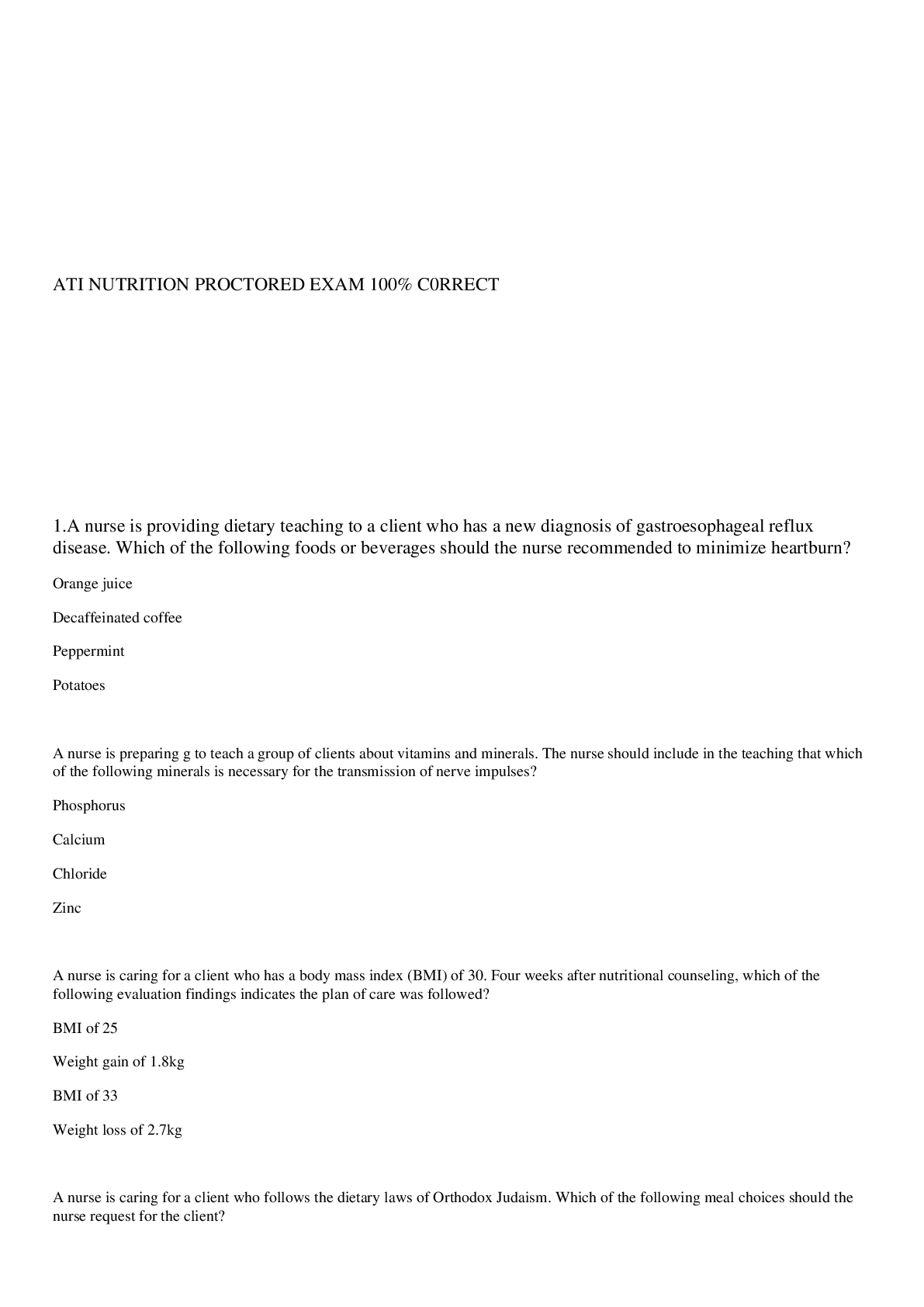
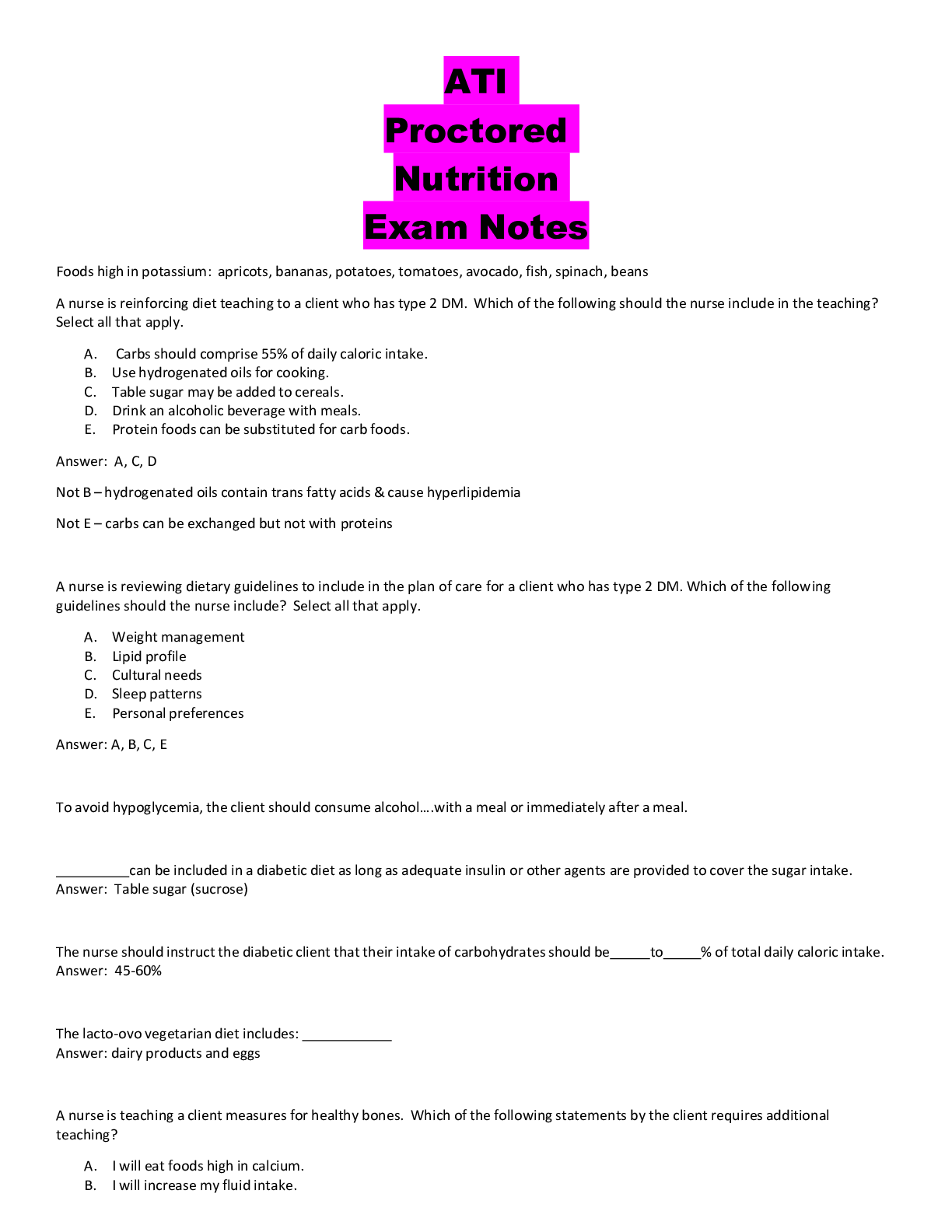


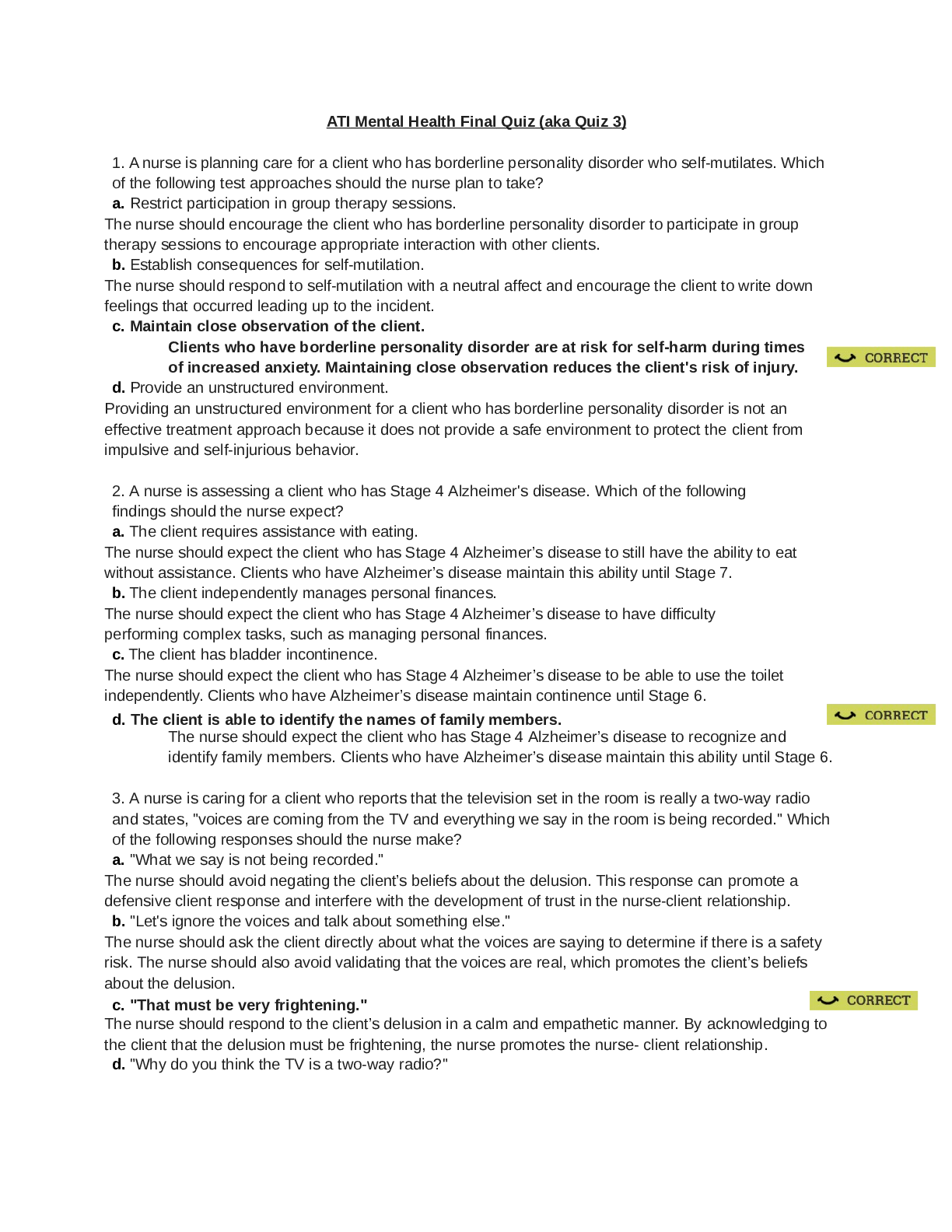
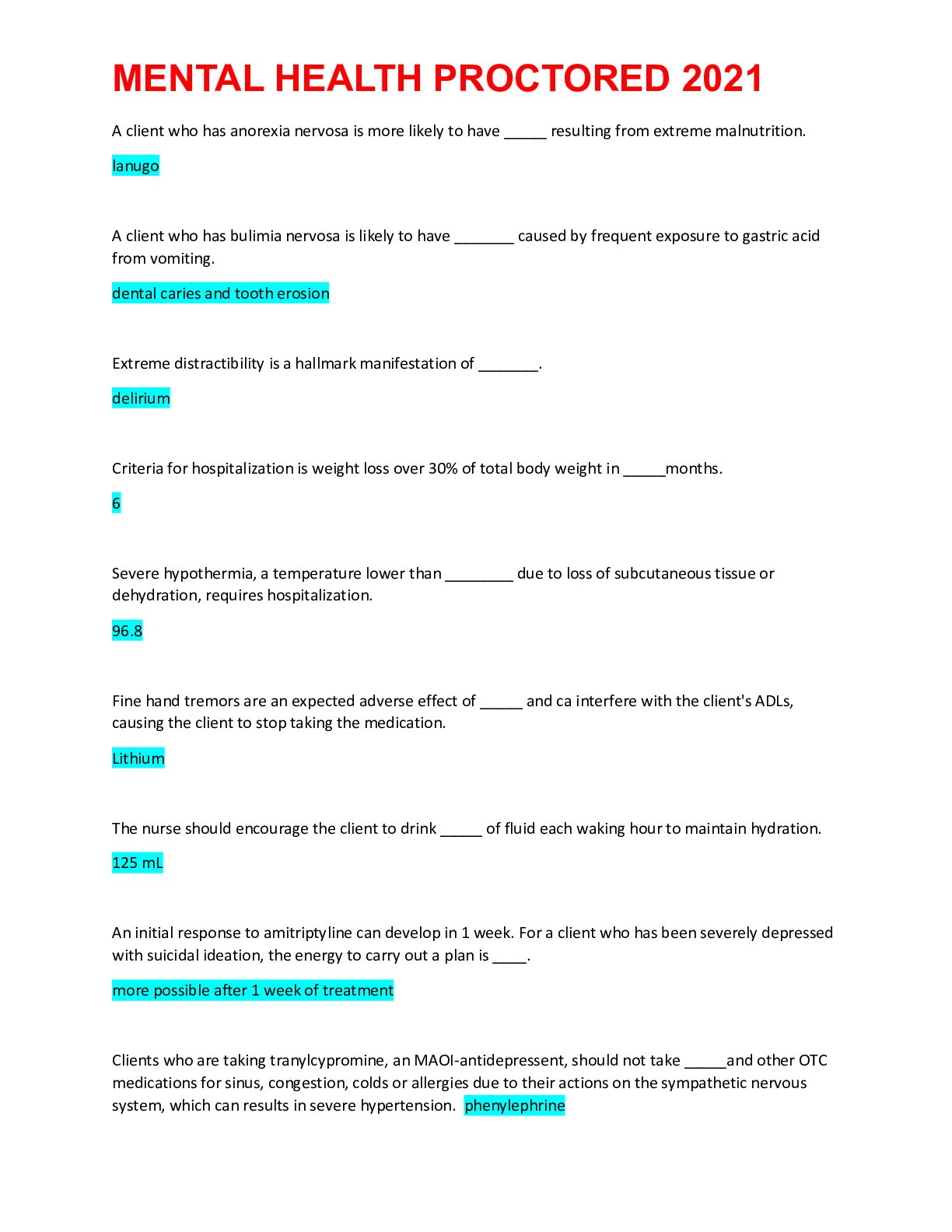

 2019 AG21.png)

